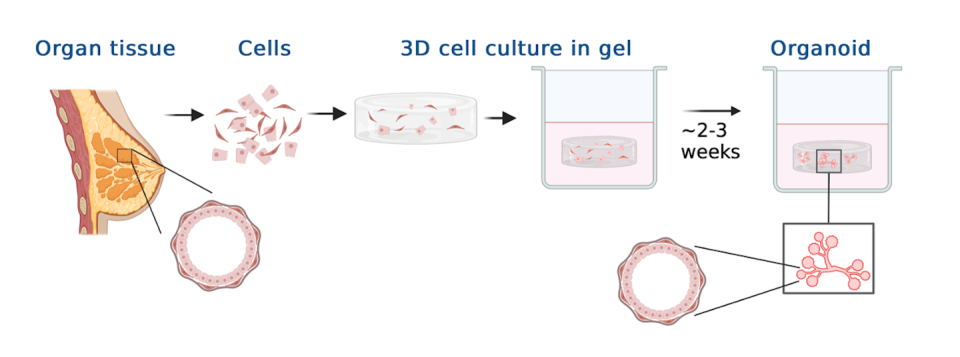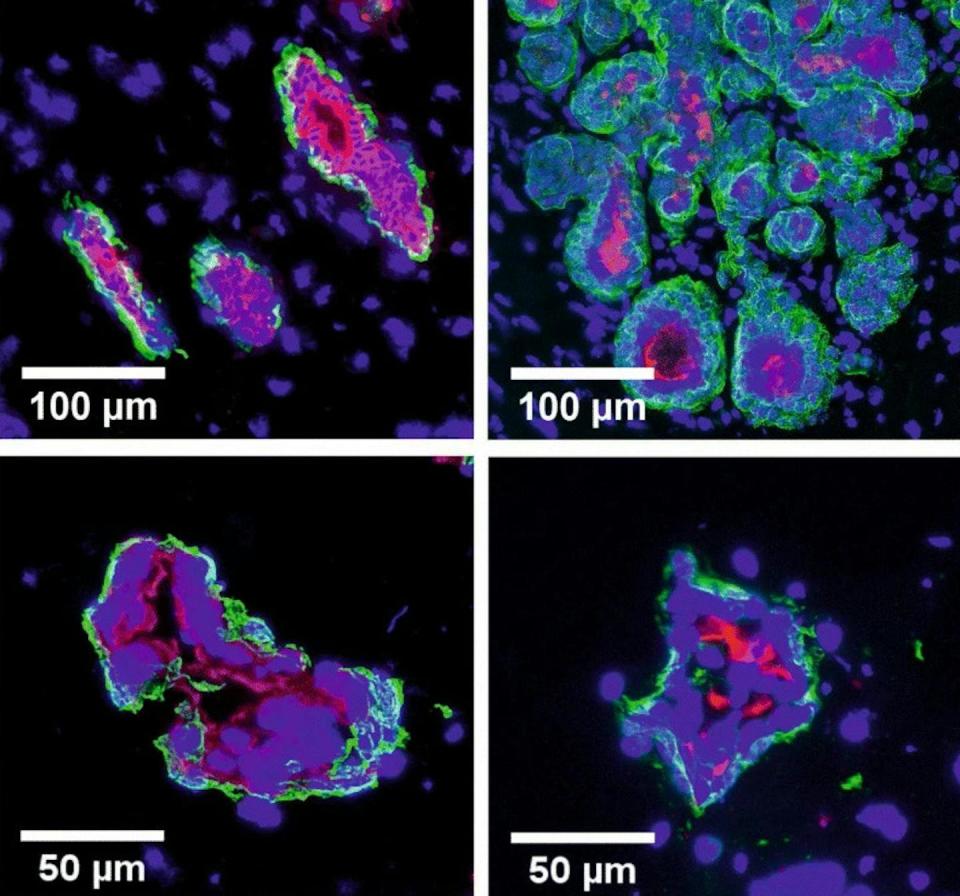All mammals have milk-producing mammary glands, a feature that has fascinated scientists for many years. Questions remain largely unanswered, including why mammary glands evolved in the first place, how they have adapted across species, and what unique evolutionary pressures shaped their development.
To investigate how diverse species develop unique solutions to biological challenges, my team at the Rauner Lab at Tufts University School of Medicine is recreating mammalian diversity in a dish through organoids, miniature versions of mammary glands. These models could shed light on the fundamental biological processes behind milk production, tissue regeneration, and the early stages of breast cancer development.
What are organoids?
Organoids are miniature, 3D structures grown in a cell culture dish that mimic the structure and function of real organs. These models are made by directing stem cells, which have the unique ability to differentiate into various cell types and form specific types of organ cells.
Although not exact miniature replicas of full-size organs, organoids contain enough cell and tissue architecture to recreate the environment and basic functions of the organ they model. For example, a mammary gland organoid or a breast tissue organoid consists of tiny long channels that terminate in a spherical structure that mimics the milk ducts and alveoli of the gland tissue.

Organoids provide a powerful tool for biomedical research because they provide a 3D representation of an organ’s structure and function. Unlike traditional 2D cell cultures, organoids can mimic the complexity of real tissues, including their architecture and variety of cell types. This allows researchers to study complex biological processes such as tissue development, regeneration, and disease progression in a controlled environment, while reducing reliance on animal models.
Mammal diversity on a plate
Researchers have traditionally used organoids to model human diseases, test drugs, and study developmental biology. However, their potential extends far beyond these applications, particularly in the field of evolutionary biology.
My research focuses on generating mammary gland organoids from a variety of mammalian species. Mammals are incredibly diverse, and each species has adapted to a wide variety of environments and lifestyles. The mammary gland, essential for feeding offspring, varies significantly across species.


For example, monotremes, such as the platypus and echidna, belong to a unique and ancient class of mammals. Monotremes split off from other mammal groups about 190 million years ago and are distinguished by their method of reproduction: laying eggs rather than giving live birth. Their mammary glands are markedly different from those of eutherian mammals, such as cows and humans, which have teats; monotremes instead secrete milk through specialized mammary hairs.
Scientists believe that different environmental pressures and reproductive strategies have driven the evolution of various forms of lactation. However, the exact mechanisms and evolutionary paths are still largely unknown. By comparing organoids from these various species, researchers can shed light on how these ancient structures evolved and adapted to meet the reproductive needs of different animals over millions of years.
Insights beyond the mammary gland
Studying the unique properties of the mammary gland may also shed light on other areas of biology and medicine.
For example, the mammary gland can renew itself during each reproductive and lactation cycle. This makes it an excellent model for studying tissue regeneration. With organoids, researchers can observe the regeneration process in real time and investigate how different species have evolved to maintain this regenerative capacity. Understanding the mechanisms behind regeneration could lead to advances in regenerative medicine, a field that focuses on repairing or replacing damaged tissues and organs in conditions such as heart disease, diabetes, and injuries.
Mammary organoids may also aid breast cancer research. Studying mammary organoids from species that rarely develop mammary tumors, such as cows and pigs, may reveal potential protective mechanisms and inform new strategies for breast cancer prevention and treatment in humans. Organoids also provide a platform to study early events in tumorigenesis and the cellular environment that contributes to cancer development.
Organoids also allow scientists to study the onset, duration, and termination of lactation in different species. The lactation process varies greatly among mammals, influenced by factors such as hormonal changes and environmental conditions. Some mammals have unique lactation patterns. For example, marsupials such as the tammar wallaby can produce two types of milk simultaneously to meet the nutritional needs of young at different stages of development; this phenomenon is called asynchronous synchronous lactation. Additionally, the fur seal can maintain lactation despite going long periods without nursing.
Studying different lactation types through mammary organoids may provide deeper insights into how lactation is regulated, revealing evolutionary adaptations that could explain the biology of human lactation and improve milk production strategies in livestock farming.
The potential of organoid technology
Organoids offer several advantages over traditional animal models. First, they provide a controlled environment for studying complex biological processes, and they increase research efficiency by allowing scientists to run multiple tests simultaneously.
They also reduce ethical concerns associated with animal research. Organoids can be produced from animals that are not suitable for live research, such as rare or endangered species.
Additionally, organoids can be genetically modified to probe specific genes and pathways, which could provide deeper insights into the molecular mechanisms underlying mammary gland biology.
While organoids are a powerful tool, they are not without their limitations. They cannot fully replicate the complexity of living tissues, and findings from organoid studies must be validated in living subjects. Despite these hurdles, advances in organoid technology continue to push the boundaries of what is possible, providing new opportunities to explore mammalian diversity and evolution.
By recreating the diversity of mammalian tissues in one dish, researchers can gain important insights into how different species have evolved to solve biological challenges, potentially benefiting human health, agriculture and nutritional science.
This article is republished from The Conversation, a nonprofit, independent news organization that brings you facts and trusted analysis to help you understand our complex world. By Gat Rauner Tufts University
Read more:
Gat Rauner receives funding from the Department of Defense Breast Cancer Research Program